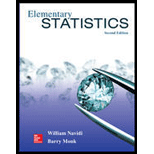
Concept explainers
Dice: Two fair dice are rolled. The first die is red and the second is blue. An experiment consists of observing the numbers that come up on the dice.
There are 36 outcomes in the
Let A be the
Let B be the event that the red die comes up 6. List the outcomes in B.
Let C be the event that one die comes up 6 and the other comes up 1. List the outcomes C.
Are events A and B mutually exclusive? Explain.
Are events A and C mutually exclusive? Explain.
a.
To find: The list of
Answer to Problem 34E
Explanation of Solution
Two fair dies are rolled. The first die is red and the second is blue. An experiment consists of observing the numbers that come up on the die.
If we toss a die there will be six outcomes
If two dies tossed together, when get “
The possible outcomes as the ordered pairs of the form (Red die, Blue die) is
b.
To find: The outcomes of the event
Answer to Problem 34E
Explanation of Solution
In both dies, we have to get the same numbers. It means that, if we got “
Therefore the possible outcomes are
c.
To find: The outcomes of the event
Answer to Problem 34E
Explanation of Solution
In red die we need to get “
Therefore the possible outcomes are
d.
To find: The outcomes of the event
Answer to Problem 34E
Explanation of Solution
If
The possible outcome
e.
To explain: Whether the two events
Answer to Problem 34E
No, both events have common elements.
Explanation of Solution
If two events are said to be mutually exclusive, it is impossible for both to occur. But the two events
f.
To explain: Whether the two events
Answer to Problem 34E
Yes, both events have no any common outcomes.
Explanation of Solution
If the two events are said to be mutually exclusive, it is impossible for both to occur. Here, the two events
Want to see more full solutions like this?
Chapter 5 Solutions
Elementary Statistics (Text Only)
- Name Harvard University California Institute of Technology Massachusetts Institute of Technology Stanford University Princeton University University of Cambridge University of Oxford University of California, Berkeley Imperial College London Yale University University of California, Los Angeles University of Chicago Johns Hopkins University Cornell University ETH Zurich University of Michigan University of Toronto Columbia University University of Pennsylvania Carnegie Mellon University University of Hong Kong University College London University of Washington Duke University Northwestern University University of Tokyo Georgia Institute of Technology Pohang University of Science and Technology University of California, Santa Barbara University of British Columbia University of North Carolina at Chapel Hill University of California, San Diego University of Illinois at Urbana-Champaign National University of Singapore…arrow_forwardA company found that the daily sales revenue of its flagship product follows a normal distribution with a mean of $4500 and a standard deviation of $450. The company defines a "high-sales day" that is, any day with sales exceeding $4800. please provide a step by step on how to get the answers in excel Q: What percentage of days can the company expect to have "high-sales days" or sales greater than $4800? Q: What is the sales revenue threshold for the bottom 10% of days? (please note that 10% refers to the probability/area under bell curve towards the lower tail of bell curve) Provide answers in the yellow cellsarrow_forwardFind the critical value for a left-tailed test using the F distribution with a 0.025, degrees of freedom in the numerator=12, and degrees of freedom in the denominator = 50. A portion of the table of critical values of the F-distribution is provided. Click the icon to view the partial table of critical values of the F-distribution. What is the critical value? (Round to two decimal places as needed.)arrow_forward
- A retail store manager claims that the average daily sales of the store are $1,500. You aim to test whether the actual average daily sales differ significantly from this claimed value. You can provide your answer by inserting a text box and the answer must include: Null hypothesis, Alternative hypothesis, Show answer (output table/summary table), and Conclusion based on the P value. Showing the calculation is a must. If calculation is missing,so please provide a step by step on the answers Numerical answers in the yellow cellsarrow_forwardShow all workarrow_forwardShow all workarrow_forward
 Glencoe Algebra 1, Student Edition, 9780079039897...AlgebraISBN:9780079039897Author:CarterPublisher:McGraw Hill
Glencoe Algebra 1, Student Edition, 9780079039897...AlgebraISBN:9780079039897Author:CarterPublisher:McGraw Hill College Algebra (MindTap Course List)AlgebraISBN:9781305652231Author:R. David Gustafson, Jeff HughesPublisher:Cengage Learning
College Algebra (MindTap Course List)AlgebraISBN:9781305652231Author:R. David Gustafson, Jeff HughesPublisher:Cengage Learning
 Holt Mcdougal Larson Pre-algebra: Student Edition...AlgebraISBN:9780547587776Author:HOLT MCDOUGALPublisher:HOLT MCDOUGALAlgebra & Trigonometry with Analytic GeometryAlgebraISBN:9781133382119Author:SwokowskiPublisher:Cengage
Holt Mcdougal Larson Pre-algebra: Student Edition...AlgebraISBN:9780547587776Author:HOLT MCDOUGALPublisher:HOLT MCDOUGALAlgebra & Trigonometry with Analytic GeometryAlgebraISBN:9781133382119Author:SwokowskiPublisher:Cengage




